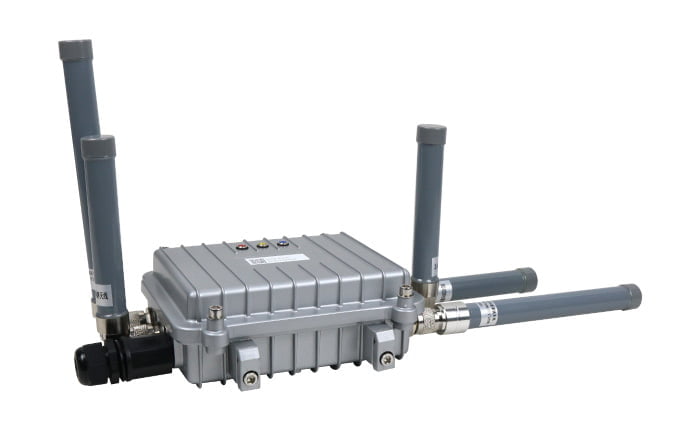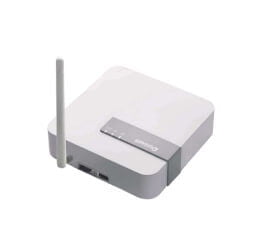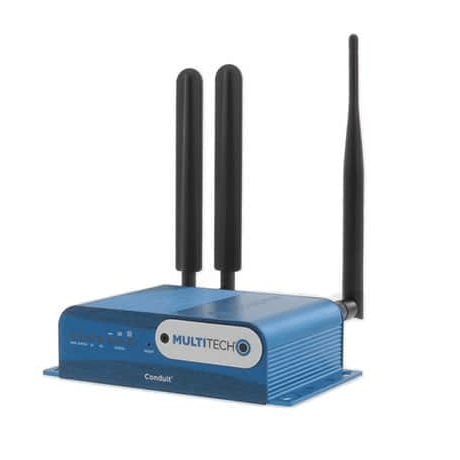A Lora gateway is a device that allows LoRaWAN devices to connect to the internet. Lora Gateways are used in LoRaWAN networks to provide a link between the end devices and the network server.
It has the advantage that the wireless range for data transmission is exceptionally high, and the energy consumption is very low – thus allowing for exceptionally long battery life.

Gateways can be configured to work in either gateway mode or end device mode. In gateway mode, the gateway connects to the network server and passes data from the end devices to the server. In end device mode, the gateway connects to an end device and passes data to and from the device.
LoRaWAN gateways are important because they allow devices to connect to the internet and make it possible to build long-range wireless networks.
All over the world, people and organizations are looking for ways to connect their devices to the internet quickly, securely, and with low power consumption. For many applications, LoRa is the best solution.
LoRa gateways act as a bridge, allowing device data to be passed to and from the internet. But with so many LoRa gateway options on the market, it can be hard to know which one is right for your needs. In this article, we’ll review three of the best LoRa gateways on the market and help you decide which one is right for your project.
Things to Consider Before Purchasing a Lora Gateway:
When it comes to LoRa IoT gateways, there are a few things you’ll need to consider before making a purchase. Here are a few factors to keep in mind:
- Coverage area – Check the coverage area of the gateway you’re considering. You’ll want to ensure that it will cover the area where you plan to use it.
- Frequency – LoRa gateways operate at a specific frequency. Ensure that the gateway you’re considering is compatible with the frequency you need.
- Protocol – LoRa gateways use a specific protocol. Ensure that the gateway you’re considering is compatible with the protocol you need.
- Power – LoRa gateways require a specific power source. Ensure that the gateway you’re considering is compatible with the power supply.
- Range – Generally, the range is equated with the antenna. This is substantially true; the lesser the gain of the antenna, the further an implicit knot can be from the gateway and still have a decent event. There are also other factors that impact this.
- Backhaul Connectivity – There are 3 main styles for transferring data from the gateway to the pall, as far as connection types go. You can moreover use Ethernet, Wi-Fi, or Cellular. There are gateways from different brands that can use any one of the forenames or a combination of any 2 or 3. All RAK wireless gateways offer Wi-Fi — the difference is whether there’s Ethernet and/ or Cellular.
- Operating Temperature Range – As one might anticipate, the out-of-door gateways can survive at lower temperatures because of their industrial enclosures, whereas the inner gateways are more limited.
- Weather Resistance – As with the temperature, out-of-door gateways are more resistant to harsh rainfall conditions with better doorway protection.
A Comparison of the Four Best Lora Gateways:
Four of LoRa gateways stand out above the rest: The Things Network (TTN) Gateway, The Link Labs Gateway, DusunIoT LoRa Gateway and The MultiTech Gateway. All three of four gateways have unique features and benefits, and we’ll compare them side-by-side to help you choose the right one for your needs.
- The TTN LoRa Gateway is the most popular LoRa gateway on the market. It’s easy to set up and use and offers a great mix of features and performance.

- The Link Labs Gateway is the most powerful LoRa gateway on the market. It offers unparalleled performance and features, making it the ideal choice for demanding applications.

- The Dusun LoRaWAN Gateway series has 3 different types of version: Indoor Outdoor LoRaWAN Gateway, indoor LoRaWAN gateway, and Indoor LoRaWAN Gateway Lite. Picking the Right LoRaWAN Hardware for Your IoT Solutions.

Outdoor LoRaWAN Gateway
DSGW-014
RAM: 1GB eMMC: 8GB
Uplink: Ethernet, Wi-Fi 2.4G/5G
Downlink: Wi-Fi 2.4G/5G, Bluetooth 5.2, LoRaWAN, GPS
LoRa Frequency: CN470, RU864, IN865, EU868, US915, AU915, KR920, AS923
Specification

Indoor LoRaWAN Gateway
RAM: 2GB eMMC: 32GB
Uplink: Ethernet, Wi-Fi 2.4G/5G
Downlink: Wi-Fi 2.4G/5G, Bluetooth 5.2, LoRaWAN, GPS
LoRa Frequency: CN470, RU864, IN865, EU868, US915, AU915, KR920, AS923
Specification

Indoor LoRaWAN Gateway Lite
RAM: 128MB eMMC: 4GB
Uplink: Ethernet, Wi-Fi 2.4G/5G
Downlink: Wi-Fi 2.4G/5G, Bluetooth 5.2, LoRaWAN, GPS
LoRa Frequency: CN470, RU864, IN865, EU868, US915, AU915, KR920, AS923
Specification
- The MultiTech Gateway is the most versatile LoRa gateway on the market. It can be used for a wide variety of applications.

The four most popular LoRa gateways on the market are the TTN Gateway, the Link Labs Gateway, DusunIoT LoRa Gateway and the MultiTech Gateway. Each gateway has its pros and cons, so it’s important to choose the right one for your needs.
What Makes a LoRaWAN Gateway Great?
The IoT LoRaWAN Gateway uses private protocols that are mostly unique and vary between brands. Users can barely free themselves from product brands when selecting suitable hardware for large-scale deployment of endpoints, gateways, and beyond. And it increases the difficulty for the new product to communicate with the existing system and may not achieve the desired result for the users.
On the contrary, the LoRaWAN gateway makes the network more accessible for common uses. Using the LoRaWAN protocol, data can seamlessly flow to these different LoRaWAN devices with only minor configuration adjustments. It creates a scalable design with the flexibility to interact between different endpoints.
Keeping this in mind, Ursalink provides robust, secure, and wireless connectivity in a wide range of environments with a large number of LoRaWAN devices such as LoRaWAN Gateway, LoRaWAN Multi-Interface Sensor, and Temperature/Humidity Sensor LoRaWAN, available for deployment in most global frequency bands, such as EU433 / CN470 / IN865 / EU868 / AU915 / US915 / KR920 / AS923, etc.
To meet the budget, the LoRa gateway usually uses the SX127X LoRa concentrator module, which is cheap but unstable. On the other hand, the LoRaWAN Gateway comes with the SX1301, with the ability to provide a continuous network connection optimized for reliable performance and easy development.
The architecture of a LoRaWAN network is quite complex, which contains the end devices, LoRaWAN gateways, network servers, and also application servers. The data is transmitted to the servers through the end nodes and finally reaches the application. Sometimes, this data-driven technology requires additional maintenance or compliance costs for the network server.
To save overhead, the Ursalink UG85/UG87 LoRaWAN Gateway is designed with an integrated network server aligning with multiple third-party network servers, the Things Network (TTN), LORIOT, etc., bringing nodes online and verifying your PoC faster.
How LORA Gateway Works:
It can be seen as clear zones that send the radio data packets to IP packets and vice versa. Therefore, gateways are connected to the LoRaWAN network server through the standard IP connections.
Generally, the LoRaWAN gateway communicates with the LNS via Wi-Fi, hardwired Ethernet, or cellular connection. LoRa gateways include an operating system where the packet forwarding software runs in the background.
In this way, the network director has further latitude in managing his gateway. The data rate between the end knot (knot or end device) and the LoRa gateway is comparatively low, but this is necessary immolation to enable long-lasting battery life and a high radio range.
The gateway itself is connected to a LoRaWAN network garçon through high-bandwidth networks similar to Wi-Fi, Ethernet, or cellular to give end-to-end connectivity between LoRa end bumps and the operation server. In a nutshell, All LoRa gateways within range of an end knot admit data from the device. Also, the gateways forward this data to the LoRaWAN network garçon.
The network garçon oversees removing indistinguishable data packets, vindicating data integrity, and performing security checks before transferring the communication to the operation garçon. In the other direction, the LNS is also responsible for opting for the stylish LoRa gateway to further all dispatches queued for the coming downlink session.
Indoor and Outdoor LORA Gateways:
Inner gateways are less sturdy and not waterproof compared to outdoor gateways. They’re generally equipped with case openings, which makes them not ideal for deployment outside as water can enter through these openings driving corrosion.
Outdoor gateways, on the other hand, are robust, and they’re finagled to be waterproof. Numerous outdoor leakproof gateways are IP67 certified, meaning they’re fully defended against dust and may indeed survive temporary absorption in the water of over 30 twinkles in depths between 15 cm and 1m. Another trait that makes a LoRaWAN gateway “weatherproof” is the larger temperature ranges covered by the installed chips.
Types of LORA Gateway:
All LoRaWAN gateways can be distributed into 2 groups Single- channel and multi-channel gateways. Single-channel gateways generally use cheaper transceivers similar to the SX1276 and the SX1272.
These savings in tackle are reflected in the overall price, making single-channel gateways a seductive choice, as they lower the hedge of entry for network suckers wanting to give LoRaWAN a pass without too important of a fiscal commitment.
Multichannel LoRaWAN gateways may be considered the “real deal,” as they’re LoRa Alliance biddable powered by much more precious but protean transceivers. These gateways can admit on 8 or 10 channels and 6 spreading factors contemporaneously.
Explore: LoRa gateway 8 channel
Which LORA Gateway Type is Best:
In terms of functionality, single-channel gateways are veritably limited. This leads to lower-than-ideal approaches to colorful network results. They can only admit to a single spreading factor and one channel at the same time.
While some single-channel gateways can switch between different spreading factors and frequentness to pretend multi-channel gateways, utmost of them only have around 2 of the capacity of a multi-channel gateway.
Another problem with single-channel gateways is the lack of downlink support. This can lead to dispatches getting lost if a network attempts to record a downlink. Devices near a single-channel gateway without downlink support won’t switch to more effective spreading factors but rather “congesting” the diapason with gratuitous transmissions.



















